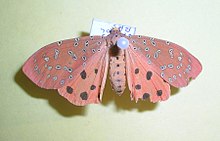Mangina argus
| Crotalaria podborer | |
|---|---|

| |
| Scientific classification | |
| Domain: | Eukaryota |
| Kingdom: | Animalia |
| Phylum: | Arthropoda |
| Class: | Insecta |
| Order: | Lepidoptera |
| Superfamily: | Noctuoidea |
| Family: | Erebidae |
| Subfamily: | Arctiinae |
| Genus: | Mangina |
| Species: | M. argus
|
| Binomial name | |
| Mangina argus (Kollar, [1847])
| |
| Synonyms | |
| |
Mangina argus (crotalaria podborer) is a moth of the family Erebidae. It is found in south-east Asia, including Zhejiang, Fujian, Jiangxi, Guangxi, Guangdong, Yunnan, Taiwan, Hunan, from southern India to Kashmir, the Himalayas, Nepal, Bhutan and Sri Lanka.[1]
Description
Adults with pinkish or brownish red head, thorax and fore wing. Two black yellow-ringed spots on collar, two spots on tegula. and three spots on thorax. The collar outlined with brilliant scarlet. Abdomen scarlet with black spots on dorsal, ventral and two paired lateral series. Fore wing with six transeverse series of yellow-ringed black spots, each series curved, irregularly disposed and variable as to size and number, the postmedial series bifurcating towards the costa. Hind wings also scarlet with one black spot at end of cell, another spot at origin of vein 2, another spot at its middle, and a submarginal series. There is a few small spots on margin, all these being somewhat variable. Larva purple-black with a few dorsal hairs. Head and a lateral line from 4th to 10th somites are reddish. A dorsal series of transverse white streaks.[2]
It is a minor pest, where the larvae feed on the young leaves of Crotalaria species, including Crotalaria juncea. They feed in groups. They bore into the pods and sometimes injure the bark. Pupation takes place in a loosely woven web or within the fold of a leaf. Pupa brownish-orange colored with black spots.[3]
References
- ^ "Mangina argus". India Biodiversity Portal. Retrieved 24 July 2016.
- ^ Hampson G. F. (1892). "The Fauna Of British India Including Ceylon And Burma Moths Vol-ii". Digital Library of India. p. 558. Retrieved 4 July 2016.[permanent dead link]
- ^ "Mangina argus (Kollar)". ICAR-National Bureau of Agricultural Insect Resources. Retrieved 24 July 2016.
External links
- The Review of applied entomology: Agricultural, Volume 18
 Data related to Mangina argus at Wikispecies
Data related to Mangina argus at Wikispecies
